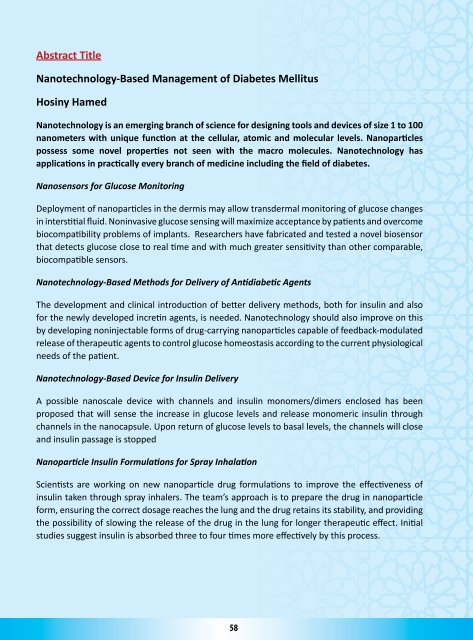Download Booklet - Diabetes in Asia Study Group
Download Booklet - Diabetes in Asia Study Group
Download Booklet - Diabetes in Asia Study Group
You also want an ePaper? Increase the reach of your titles
YUMPU automatically turns print PDFs into web optimized ePapers that Google loves.
Abstract Title<br />
Nanotechnology-Based Management of <strong>Diabetes</strong> Mellitus<br />
Hos<strong>in</strong>y Hamed<br />
Nanotechnology is an emerg<strong>in</strong>g branch of science for design<strong>in</strong>g tools and devices of size 1 to 100<br />
nanometers with unique function at the cellular, atomic and molecular levels. Nanoparticles<br />
possess some novel properties not seen with the macro molecules. Nanotechnology has<br />
applications <strong>in</strong> practically every branch of medic<strong>in</strong>e <strong>in</strong>clud<strong>in</strong>g the field of diabetes.<br />
Nanosensors for Glucose Monitor<strong>in</strong>g<br />
Deployment of nanoparticles <strong>in</strong> the dermis may allow transdermal monitor<strong>in</strong>g of glucose changes<br />
<strong>in</strong> <strong>in</strong>terstitial fluid. non<strong>in</strong>vasive glucose sens<strong>in</strong>g will maximize acceptance by patients and overcome<br />
biocompatibility problems of implants. researchers have fabricated and tested a novel biosensor<br />
that detects glucose close to real time and with much greater sensitivity than other comparable,<br />
biocompatible sensors.<br />
Nanotechnology-Based Methods for Delivery of Antidiabetic Agents<br />
the development and cl<strong>in</strong>ical <strong>in</strong>troduction of better delivery methods, both for <strong>in</strong>sul<strong>in</strong> and also<br />
for the newly developed <strong>in</strong>cret<strong>in</strong> agents, is needed. nanotechnology should also improve on this<br />
by develop<strong>in</strong>g non<strong>in</strong>jectable forms of drug-carry<strong>in</strong>g nanoparticles capable of feedback-modulated<br />
release of therapeutic agents to control glucose homeostasis accord<strong>in</strong>g to the current physiological<br />
needs of the patient.<br />
Nanotechnology-Based Device for Insul<strong>in</strong> Delivery<br />
a possible nanoscale device with channels and <strong>in</strong>sul<strong>in</strong> monomers/dimers enclosed has been<br />
proposed that will sense the <strong>in</strong>crease <strong>in</strong> glucose levels and release monomeric <strong>in</strong>sul<strong>in</strong> through<br />
channels <strong>in</strong> the nanocapsule. upon return of glucose levels to basal levels, the channels will close<br />
and <strong>in</strong>sul<strong>in</strong> passage is stopped<br />
Nanoparticle Insul<strong>in</strong> Formulations for Spray Inhalation<br />
scientists are work<strong>in</strong>g on new nanoparticle drug formulations to improve the effectiveness of<br />
<strong>in</strong>sul<strong>in</strong> taken through spray <strong>in</strong>halers. the team’s approach is to prepare the drug <strong>in</strong> nanoparticle<br />
form, ensur<strong>in</strong>g the correct dosage reaches the lung and the drug reta<strong>in</strong>s its stability, and provid<strong>in</strong>g<br />
the possibility of slow<strong>in</strong>g the release of the drug <strong>in</strong> the lung for longer therapeutic effect. <strong>in</strong>itial<br />
studies suggest <strong>in</strong>sul<strong>in</strong> is absorbed three to four times more effectively by this process.<br />
58


